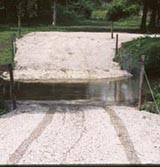Concentrated Animal Feeding Operations (CAFO)
CAFOs and the EPA
The National Pollutant Discharge Elimination System (NPDES) program regulates the discharge of pollutants from point sources to waters of the United States. Concentrated Animal Feeding Operations (CAFOs) are defined as point sources by the Clean Water Act of 1972 and may therefore be regulated under the NPDES permitting program as point sources. Point sources are pipes, man-made ditches or other recognized conveyances from which animal waste and wastewater can enter water bodies from spills or breaks of waste storage structures (due to accidents or excessive rain), and non-agricultural application of manure to crop land.
Previous EPA regulations based the definition of CAFOs on the number of "animal units" confined. EPA no longer uses the term "animal unit," but instead refers to the actual number of animals at the operation when defining a CAFO. For a brief summary of how the regulations define Large, Medium, and Small CAFOs, click [here]. Keep in mind, however, that the NPDES permitting authority may also designate any medium or small AFO as a CAFO. Such a designation is only done on a case-by-case basis after conducting an on-site inspection and finding that the facility "is a significant contributor of pollutants to waters of the United States."

